The French silent film serial Les Mystères de Paris/The Mysteries of Paris (Charles Burguet, 1922) is based on one of the most famous French novels in the 19th century. This serial novel by Eugène Sue was published in a French newspaper in 90 parts from 1842 to 1843. Novel and film delve in the seediest parts of Paris and have a sinister-looking gallery of unforgettable characters, including Monsieur Pipelet, La Chouette (the Owl), Le Maître d'école (the Schoolmaster) and Le Chourineur.
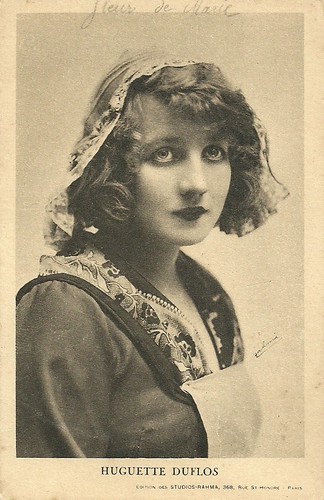
French postcard by Edition des Studios-Rahma, Paris. Photo: Huguette Duflos as Fleur-de-Marie in Les Mystères de Paris/The Mysteries of Paris (Charles Burguet, 1922).
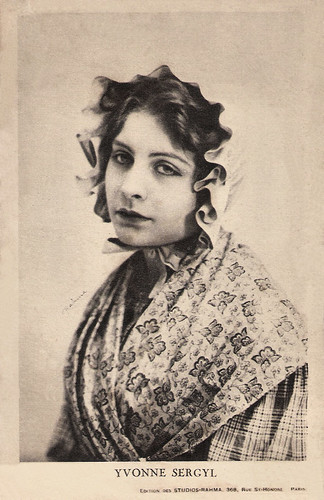
French postcard by Edition des Studios-Rahma, Paris. Photo: Rhama. Publicity still for Les Mystères de Paris/The Mysteries of Paris (Charles Burguet, 1922) with Yvonne Sergyl as Louise Morel.
The hero of the novel and the film is the mysterious and distinguished Rodolphe, disguised as a Parisian worker but in fact the Grand Duke of Gerolstein, a fictional kingdom of Germany. Rodolphe can speak in argot, is extremely strong and a good fighter.
Yet Rodolphe also shows great compassion for the lower classes, good judgement, and a brilliant mind. He can navigate all layers of society in order to understand their problems, and to understand how the different social classes are linked. Rodolphe is accompanied by his friends Sir Walter Murph, an Englishman, and David, a gifted black doctor, formerly a slave.
The first figures they meet are Le Chourineur and La Goualeuse. Rodolphe saves La Goualeuse from Le Chourineur's brutality, and saves Le Chourineur from himself, knowing that the man still has some good in him. La Goualeuse is a prostitute, and Le Chourineur is a former butcher who has served 15 years in prison for murder.
Both characters are grateful for Rodolphe's assistance, as are many other characters in the novel. At the end, Rodolphe goes back to Gerolstein to take on the role to which he was destined by birth.
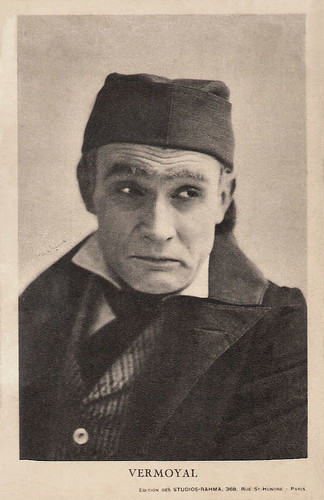
French postcard by Edition des Studios-Rahma, Paris. Photo: Rhama. Publicity still for Les Mystères de Paris/The Mysteries of Paris (Charles Burguet, 1922) with Paul Vermoyal as Le Notaire Ferrand (the Notary Ferrand).
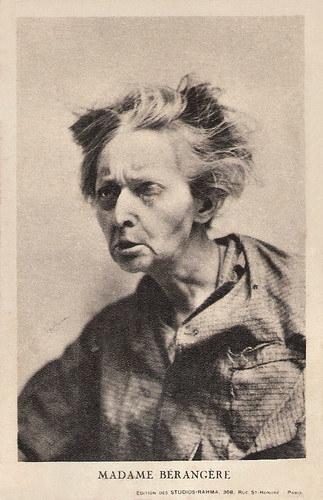
French postcard by Edition des Studios-Rahma, Paris. Photo: Rhama. Publicity still for Les Mystères de Paris/The Mysteries of Paris (Charles Burguet, 1922) with Jeanne Bérangère as La Chouette (the Owl).
The original novel was very long, in some editions over 1000 pages. But Les Mystères de Paris was an instant success, and singlehandedly increased the circulation of the newspaper Journal des débats.
Eugène Sue was the first author to bring together so many characters from different levels of society within one novel, and thus his book was popular with readers from all classes. He showed how vice was not the only cause of suffering, but also caused by inhumane social conditions.
Les Mystères de Paris is melodramatic depicting a world where good and evil are clearly distinct. The novel was partly inspired by the Memoirs (1828) of the French criminal and criminalist Eugène François Vidocq, and by the works of James Fenimore Cooper: Sue took the plot structure of the Natty Bumppo novels and moved them to the city where buildings replaced trees and underworld gangs replaced Indians.
Les Mystères de Paris paved the way for Victor Hugo's Les misérables and founded the ‘City mysteries’ genre, that explored the ‘mysteries and miseries’ of cities, like Les Mystères de Marseille by Émile Zola, Les Mystères de Londres by Paul Féval, and Les Nouveaux Mystères de Paris (featuring Nestor Burma) by Léo Malet. In America, Ned Buntline wrote The Mysteries and Miseries of New York in 1848.
In 1988, Michael Chabon paid tribute to the genre with The Mysteries of Pittsburgh.
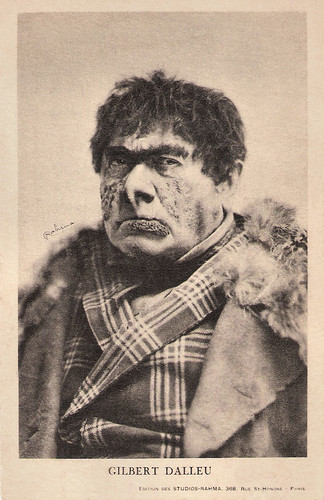
French postcard by Edition des Studios-Rahma, Paris. Photo: Rhama. Publicity still for Les Mystères de Paris/The Mysteries of Paris (Charles Burguet, 1922) with Gilbert Dalleu as Le Maître d'école (the School Teacher).
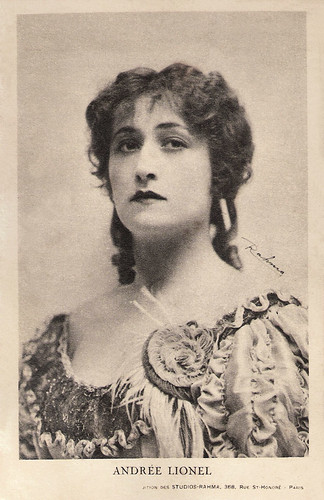
French postcard by Edition des Studios-Rahma, Paris. Photo: Rhama. Publicity still for Les Mystères de Paris/The Mysteries of Paris (Charles Burguet, 1922) with Andrée Lionel as Sarah MacGrégor.
Les Mystères de Paris has been adapted several times for the stage and for the cinema. The first film adaptation, Les mystères de Paris (1909) was a short silent film by Victorin-Hippolyte Jasset for Éclair. Camille Bardou, who would return in the 1922 version, was in the cast.
The next adaptation, Les mystères de Paris/Mysteries of Paris (1912), was made by Albert Cappellani for Pathé Frères. His brother Paul Capellani starred as Rodolphe.
In Italy, Gustavo Serena directed and starred in a four-part serial, Parigi misteriosa (1917) for Caesar Film. The same year, another Italian film company, Megale Film, produced a competitive version, Il ventre di Parigi (Ubaldo Maria Del Colle, 1917).
In 1920 followed a little known American version, The Mysteries of Paris (1920), directed by Ed Cornell for the Hub Cinemagraph Company of Boston. Two years later came another American version, Secrets of Paris (Kenneth S. Webb, 1922), with Lew Cody as King Rudolph and Montagu Love as the Schoolmaster.
That same year the film serial Les mystères de Paris (Charles Burguet, 1922) was produced in France. The 12 episodes were written by André-Paul Antoine and director Charles Burguet. This serial had a stellar cast. Georges Lannes starred as Rodolphe. He was surrounded by such well known stars as Huguette Duflos as Fleur-de-Marie, Suzanne Bianchetti as Marquise d'Harville, Gaston Modot, Charles Lamy and the young Pierre Fresnay.
Then, Henry Rollan played Rodolphe in the first sound version, Les mystères de Paris (Félix Gandéra, 1935). In Jacques de Baroncelli's version of 1943 Marcel Herrand played Rodolphe. In 1957 followed an Italian-French coproduction, I misteri di Parigi (Fernando Cerchio, 1957) with Frank Villard as Rodolpho. There were also TV versions, such as Les mystères de Paris (Marcel Cravenne, 1961) with Jacques Dacqmine.
The best known sound film version is the French-Italian Swashbuckler Les Mystères de Paris (André Hunebelle, 1962), starring Jean Marais. Hunebelle's treatment keeps from Eugène Sue nothing but the proper nouns. Db du monteil writes at IMDb that the film has “a muddled screenplay, even more far-fetched than Sue's mammoth work.”
The most recent adaptation was the six-episode miniseries Les mystères de Paris (André Michel, 1980), a French-German coproduction with Sigmar Solbach as Rodolph. Db du Monteil: “Although its running time is six hours and it's got a fine score, this made-for-TV work does not really succeed in recreating Sue's world. It's too clean, much too clean, the seediest parts of Paris are anything but Dantesque. A good thing was to use a German actor to play Rodolphe but it's not enough. I'm still waiting for the director who will do Sue's extravaganza justice.”
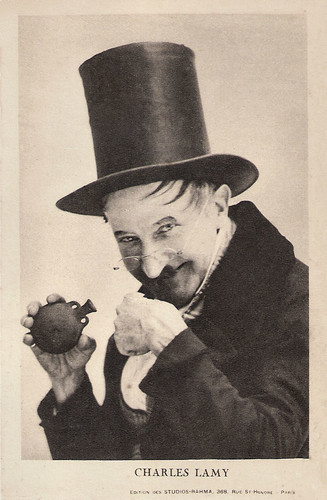
French postcard by Edition des Studios-Rahma, Paris. Photo: Rhama. Publicity still for Les Mystères de Paris/The Mysteries of Paris (Charles Burguet, 1922) with Charles Lamy as M. Pipelet.
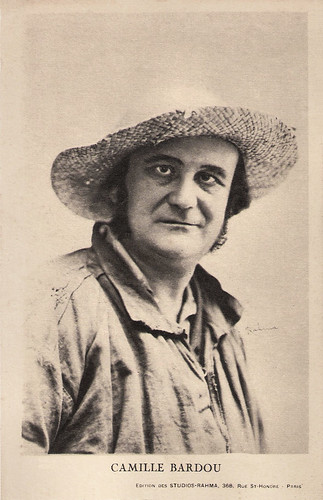
French postcard by Edition des Studios-Rahma, Paris. Photo: Rhama. Publicity still for Les Mystères de Paris/The Mysteries of Paris (Charles Burguet, 1922) with Camille Bardou as Le Courineur.
Sources: db du Monteil (IMDb), AllMovie, Wikipedia and IMDb.

French postcard by Edition des Studios-Rahma, Paris. Photo: Huguette Duflos as Fleur-de-Marie in Les Mystères de Paris/The Mysteries of Paris (Charles Burguet, 1922).

French postcard by Edition des Studios-Rahma, Paris. Photo: Rhama. Publicity still for Les Mystères de Paris/The Mysteries of Paris (Charles Burguet, 1922) with Yvonne Sergyl as Louise Morel.
Great compassion for the lower classes
The hero of the novel and the film is the mysterious and distinguished Rodolphe, disguised as a Parisian worker but in fact the Grand Duke of Gerolstein, a fictional kingdom of Germany. Rodolphe can speak in argot, is extremely strong and a good fighter.
Yet Rodolphe also shows great compassion for the lower classes, good judgement, and a brilliant mind. He can navigate all layers of society in order to understand their problems, and to understand how the different social classes are linked. Rodolphe is accompanied by his friends Sir Walter Murph, an Englishman, and David, a gifted black doctor, formerly a slave.
The first figures they meet are Le Chourineur and La Goualeuse. Rodolphe saves La Goualeuse from Le Chourineur's brutality, and saves Le Chourineur from himself, knowing that the man still has some good in him. La Goualeuse is a prostitute, and Le Chourineur is a former butcher who has served 15 years in prison for murder.
Both characters are grateful for Rodolphe's assistance, as are many other characters in the novel. At the end, Rodolphe goes back to Gerolstein to take on the role to which he was destined by birth.

French postcard by Edition des Studios-Rahma, Paris. Photo: Rhama. Publicity still for Les Mystères de Paris/The Mysteries of Paris (Charles Burguet, 1922) with Paul Vermoyal as Le Notaire Ferrand (the Notary Ferrand).

French postcard by Edition des Studios-Rahma, Paris. Photo: Rhama. Publicity still for Les Mystères de Paris/The Mysteries of Paris (Charles Burguet, 1922) with Jeanne Bérangère as La Chouette (the Owl).
City Mysteries genre
The original novel was very long, in some editions over 1000 pages. But Les Mystères de Paris was an instant success, and singlehandedly increased the circulation of the newspaper Journal des débats.
Eugène Sue was the first author to bring together so many characters from different levels of society within one novel, and thus his book was popular with readers from all classes. He showed how vice was not the only cause of suffering, but also caused by inhumane social conditions.
Les Mystères de Paris is melodramatic depicting a world where good and evil are clearly distinct. The novel was partly inspired by the Memoirs (1828) of the French criminal and criminalist Eugène François Vidocq, and by the works of James Fenimore Cooper: Sue took the plot structure of the Natty Bumppo novels and moved them to the city where buildings replaced trees and underworld gangs replaced Indians.
Les Mystères de Paris paved the way for Victor Hugo's Les misérables and founded the ‘City mysteries’ genre, that explored the ‘mysteries and miseries’ of cities, like Les Mystères de Marseille by Émile Zola, Les Mystères de Londres by Paul Féval, and Les Nouveaux Mystères de Paris (featuring Nestor Burma) by Léo Malet. In America, Ned Buntline wrote The Mysteries and Miseries of New York in 1848.
In 1988, Michael Chabon paid tribute to the genre with The Mysteries of Pittsburgh.

French postcard by Edition des Studios-Rahma, Paris. Photo: Rhama. Publicity still for Les Mystères de Paris/The Mysteries of Paris (Charles Burguet, 1922) with Gilbert Dalleu as Le Maître d'école (the School Teacher).

French postcard by Edition des Studios-Rahma, Paris. Photo: Rhama. Publicity still for Les Mystères de Paris/The Mysteries of Paris (Charles Burguet, 1922) with Andrée Lionel as Sarah MacGrégor.
Doing Sue's extravaganza justice
Les Mystères de Paris has been adapted several times for the stage and for the cinema. The first film adaptation, Les mystères de Paris (1909) was a short silent film by Victorin-Hippolyte Jasset for Éclair. Camille Bardou, who would return in the 1922 version, was in the cast.
The next adaptation, Les mystères de Paris/Mysteries of Paris (1912), was made by Albert Cappellani for Pathé Frères. His brother Paul Capellani starred as Rodolphe.
In Italy, Gustavo Serena directed and starred in a four-part serial, Parigi misteriosa (1917) for Caesar Film. The same year, another Italian film company, Megale Film, produced a competitive version, Il ventre di Parigi (Ubaldo Maria Del Colle, 1917).
In 1920 followed a little known American version, The Mysteries of Paris (1920), directed by Ed Cornell for the Hub Cinemagraph Company of Boston. Two years later came another American version, Secrets of Paris (Kenneth S. Webb, 1922), with Lew Cody as King Rudolph and Montagu Love as the Schoolmaster.
That same year the film serial Les mystères de Paris (Charles Burguet, 1922) was produced in France. The 12 episodes were written by André-Paul Antoine and director Charles Burguet. This serial had a stellar cast. Georges Lannes starred as Rodolphe. He was surrounded by such well known stars as Huguette Duflos as Fleur-de-Marie, Suzanne Bianchetti as Marquise d'Harville, Gaston Modot, Charles Lamy and the young Pierre Fresnay.
Then, Henry Rollan played Rodolphe in the first sound version, Les mystères de Paris (Félix Gandéra, 1935). In Jacques de Baroncelli's version of 1943 Marcel Herrand played Rodolphe. In 1957 followed an Italian-French coproduction, I misteri di Parigi (Fernando Cerchio, 1957) with Frank Villard as Rodolpho. There were also TV versions, such as Les mystères de Paris (Marcel Cravenne, 1961) with Jacques Dacqmine.
The best known sound film version is the French-Italian Swashbuckler Les Mystères de Paris (André Hunebelle, 1962), starring Jean Marais. Hunebelle's treatment keeps from Eugène Sue nothing but the proper nouns. Db du monteil writes at IMDb that the film has “a muddled screenplay, even more far-fetched than Sue's mammoth work.”
The most recent adaptation was the six-episode miniseries Les mystères de Paris (André Michel, 1980), a French-German coproduction with Sigmar Solbach as Rodolph. Db du Monteil: “Although its running time is six hours and it's got a fine score, this made-for-TV work does not really succeed in recreating Sue's world. It's too clean, much too clean, the seediest parts of Paris are anything but Dantesque. A good thing was to use a German actor to play Rodolphe but it's not enough. I'm still waiting for the director who will do Sue's extravaganza justice.”

French postcard by Edition des Studios-Rahma, Paris. Photo: Rhama. Publicity still for Les Mystères de Paris/The Mysteries of Paris (Charles Burguet, 1922) with Charles Lamy as M. Pipelet.

French postcard by Edition des Studios-Rahma, Paris. Photo: Rhama. Publicity still for Les Mystères de Paris/The Mysteries of Paris (Charles Burguet, 1922) with Camille Bardou as Le Courineur.
Sources: db du Monteil (IMDb), AllMovie, Wikipedia and IMDb.
1 comment:
This film was on TCM recently. Sorry I didn't record it.
Post a Comment